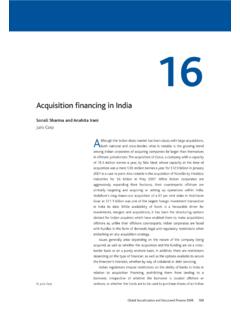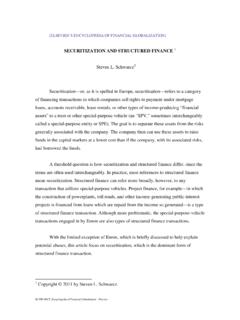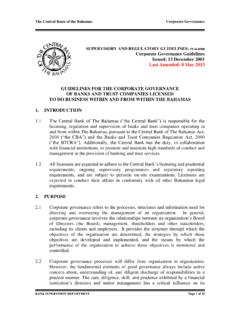Transcription of The rise of the new Shadow Bank - BET AND BETTER
1 March 3, 2015 EQUITY RESEARCHRyan M. Nash, Sachs & Beardsley, CFA Sachs & 1 The rise of the new Shadow BankThe Future of FinanceFrom Lending Club to Quicken Loans, Kabbage to CommonBond, new faces and new names are impacting the way we bank and borrow. The twin forces of regulation and technology are opening the door for an expanding class of competitors to capture profit pools long controlled by banks. In the first of a new series on the evolution of the financial industry, we focus on the new entrants into lending and where these new Shadow banks are likely to gain the strongest foothold. Goldman Sachs does and seeks to do business with companies covered in its research reports. As a result, investors should be aware that the firm may have a conflict of interest that could affect the objectivity of this report. Investors should consider this report as only a single factor in making their investment decision.
2 For Reg AC certification and other important disclosures, see the Disclosure Appendix, or go to Analysts employed by nonUS affiliates are not registered/qualified as research analysts with FINRA in the 3, 2015 Americas: Financial Services Goldman Sachs Global Investment Research 2 Contents PM summary: The coming of the new Shadow bank 3 Personal lending: Technology and regulation driving new entrants 12 Small business lending: technology driving new entrants 23 Leveraged lending: Banks burden presents a non- bank opportunity 32 Student lending disintermediating Uncle Sam 43 Mortgage banking the rise (and fall) of the non- bank 50 Commercial real estate lending niche opportunity for non-banks, but market structure largely unchanged 59 Appendix: Summary of private players 65 Disclosure Appendix 66 FinancialsPaymentsInternetSoftwareManage mentRyan M. Nash, CFAJ ames Schneider, Terry, CFAGreg Dunham, CFAR obert D.
3 Beardsley, Prasad BorraDebra SchwartzFrank RamsdenJeffrey ChenTina SunMark Lengler, CFAJ ordan Joon LeeMargarite 3, 2015 Americas: Financial Services Goldman Sachs Global Investment Research 3 PM summary: The coming of the new Shadow bank Regulatory changes and new technologies are re-shaping competition in traditional bank activities as well as the payments ecosystem. We expect the competitive landscape to shift over the next 5-10 years, with new entrants emerging and some activities moving out of the banking system. Within this report our first in a series we focus on the emergence of Shadow Banking (broadly defined as lending activities conducted outside the banking system) across several key asset classes and the potential profit pools that could be captured by disruptors. Our key takeaways: Regulation will continue to shift activities from banks to non-banks: New regulations are playing a key role in the evolution of competition as 1) stricter capital requirements have led to reduced credit availability in some lending areas, 2) scrutiny around high risk lending has led banks to pull back from some commercial activities such as loans to non-investment grade companies (aka leveraged lending), and 3) changes in the consumer market have led to an upward re-pricing of credit, providing an opening for alternative players.
4 This is leading to the emergence of a class of Shadow banks - companies like Lending Club and CommonBond have formed, while traditional borrowers like Blackstone and other asset managers/private equity firms are now becoming lenders. Technology an enabler to entry: The combination of big data analytics and new distribution channels allowed technology start-ups to disrupt traditional banks, particularly in the consumer lending space. These new entrants benefit from lower cost bases than banks, allowing them to price loans at lower interest rates. Though trends are still in their infancy, the total addressable market is large and share is shifting rapidly. New technology is also expanding the pie in markets that were historically underserved by banks. $11bn annual profit at risk to leave the banking system: We see the largest risk of disintermediation by non-traditional players in: 1) consumer lending, 2) small business lending, 3) leveraged lending ( , loans to non-investment grade businesses), 4) mortgage banking (both origination and servicing), 5) commercial real estate and 6) student lending.
5 In all, banks earned ~$150bn in 2014, and we estimate $11bn+ (7%) of annual profit could be at risk from non- bank disintermediation over the next 5+ years. Assessing the reaction of incumbents and sustainability: Emerging players will force the incumbents to change competitive behavior. For instance, we would expect pricing of products to adjust, driving potentially lower returns. Second, some could be forced to acquire, which would likely cannibalize the existing business. This opens the debate whether you are BETTER to cannibalize yourself at the expense of your current business model or remain under attack. Lastly, incumbents could pursue new regulations that level the playing field. Indeed, the regulatory outlook for non- bank financial companies has been top of mind in Washington, particularly as emerging players become large. Exhibit 1: Profit pools at risk Source: Goldman Sachs Global Investment Research estimates.
6 TypeTotal market sizeMarket size type% inside banking systemAmount in banking system% in banking system at risk of leavingAmount at banks at risk of leavingTotal banking profit pool at riskSelect disruptors / new entrantsCompetitive advantage?Unsecured personal lending$843bnLoans O/S81%$683bn31%$209bn$ Club, ProsperLower capital requirement, technologySmall business loans$186bnLoans O/S95%$177bn100%$177bn$ , KabbageTechnology (drives time, convenience)Leveraged lending$832bnLoans O/S7%$57bn34%$19bn$ AM, BDCsRegulatoryStudent lending$1,222bnLoans O/S5%$65bn100%$65bn$ , Earnest, CommonBondRegulatory, technology, convenienceMortgage origination$1,169bn Ann'l volume58%$678bn100%$678bn$ , PFSI, FreedomRegulatory, convenienceMortgage servicing$6,589bnLoans O/S73%$4,810bn6%$300bn$ , NSM, WACR egulatory, costCRE lending$2,354bnLoans O/S56%$1,322bn9%$118bn$ mREITS, alt. lendersRegulatory, market dislocationTotal$13,195bn59%$7,792bn20%$ 1,566bn$ 3, 2015 Americas: Financial Services Goldman Sachs Global Investment Research 5 A brief history of Shadow banking in the While Shadow Banking is a broad term, we define it as activities primarily lending conducted by non- bank financial intermediaries that provide services similar to traditional banks.
7 In general, these institutions are not today subject to the same regulatory oversight as traditional banks, providing a temporary arbitrage opportunity for non-banks. Though large portions of the broader Shadow banking sector (inclusive of mortgage backed securities and other structured credit) have contracted since the recession, new forms of Shadow banking have emerged and older ones have rebounded as a direct result of regulatory changes for banks, particularly 1) the Dodd-Frank Wall Street Reform and Consumer Protection Act, the financial regulatory reform bill passed in Congress in 2010 after the financial crisis, and 2) evolving bank capital standards (aka Basel III). These regulatory changes have lowered returns on equity for certain products, causing banks to raise prices or shrink various businesses, thereby creating an opportunity for new entrants. Origins of the term Shadow banking are rooted in the financial crisis The term Shadow banking was coined in 2007 by PIMCO s former chief economist Paul McCulley to refer to the the whole alphabet soup of levered up non- bank investment conduits, vehicles, and structures that contributed to the lending boom from 2005-2007.
8 These highly levered investment vehicles were reliant on wholesale short-term funding (such as commercial paper) and did not have the stability of banks FDIC insured deposits or the backstop of the Fed s discount window, and thus were vulnerable to runs when bond market liquidity dried up. Though many of these vehicles were tied to or created by banks, they generally operated outside of Fed regulation. Thus, Shadow banking has typically been a term used to criticize the systemic risks created by non- bank entities. Exhibit 2: The role of the broader Shadow banking system has declined as a % of the financial system since the financial crisis, but it is still significantly larger than history % of financial liabilities Source: Federal Reserve, Goldman Sachs Global Investment Research Sizing the Shadow bank market and bank profit pools at risk In 2013, the Federal Reserve estimated gross Shadow banking liabilities in the (their measure of non- bank credit intermediation) at roughly $15 trillion, down 30% from a peak of $22 trillion in 2007 (vs.)
9 bank liabilities growing from $14 trillion to $16 trillion over the same period). The contraction of Shadow banking liabilities is not surprising considering that the Fed s broad definition includes all structured credit (including asset backed securities now consolidated on bank balances following accounting rule changes), as well as commercial paper, repo and money market mutual funds. Additionally, during the financial crisis, several of the largest non-banks (particularly the investment banks) converted to Fed-regulated bank holding companies, further reducing the Shadow bank universe. 0%10%20%30%40%50%60%70%80%90%100%1952 1956 1960 1964 1968 1972 1976 1980 1984 1988 1992 1996 2000 2004 2008 2012 Traditional banks % of financial liabilitiesShadow banks % of financial liabilitiesMarch 3, 2015 Americas: Financial Services Goldman Sachs Global Investment Research 6 Exhibit 3: We estimate $11bn of banking profit could shift to non-banks Exhibit 4: The broader measure of Shadow banks has declined partly due to a 9% contraction in structured credit ($bn) Source: Federal Reserve, Goldman Sachs Global Investment Research.
10 Source: S&P, SIFMA, Goldman Sachs Global Investment Research. Our analysis of Shadow banking takes a narrower approach to the market focused on consumer/commercial lending and mortgage servicing or what we refer to as the new Shadow bank . Across six key lending segments with $12 trillion loans across banks and non-banks, we estimate that 59% were held on bank balance sheets (or serviced by banks in the case of mortgages), while non-banks held 41%. This compares to the Fed s measure of $15 trillion Shadow bank liabilities with 52% inside the banking system. Across these segments, we estimate that banks could lose roughly $11bn of profit to non-banks. The 'new' Shadow bank In this report, we focus on a new class of Shadow banks that are emerging new entrants such as Lending Club, Prosper, Kabbage that are changing the face of traditional activities, while other players who were historically users of credit private equity firms in particular are leveraging new regulations to play a bigger role in lending, a trend we expect to continue.




